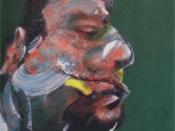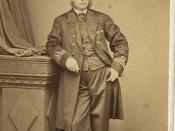Much of Bacon's work is perceived as shocking, but there is a powerful subversive element in his compositions with much of his chosen subject matter being somewhat autobiographical.
These often dealt with his own homosexuality, and his intimate and often anguished relationships. While in later life Bacon generally claimed that his sexuality was public knowledge, and that it was no secret, the press had severe problems addressing his private/public life. The greatest difficulties were over whether he had, or had not gone public about his homosexuality, and the 'content' of his art. One of his favorite ways of avoiding a direct question was to say:
"If you talk about it, why paint it?"
This is reminiscent of a quote by his acknowledged mentor Picasso:
"My work is like a diary. To understand it, you have to see how it mirrors my life."
He did once however refer to Dyer as being: "...the
great love of my life."
and therefore it is not surprising that there are a number of portraits of him.
The "Portrait of George Dyer in a Mirror", shows Dyer sitting in what looks like a swivel office chair, his disembodied face, split down the center, reflected in a lectern-like stand. He sits in a simplistic room, under a spotlight, suggestive of other Bacon paintings. On the painting are two splurges of white paint splashed across the surface, defacing the image. Whether hinting at the sexual dimension of their relationship, or of the need to assert a particular personal expression of possession, even in an image, it was Bacons way of going public on a profound and deeply important aspect of his emotional life.
This painting of Dyer presented his lover as twisted, distorted and virtually disembodied. There is a suggestion of a dream-like state in...


